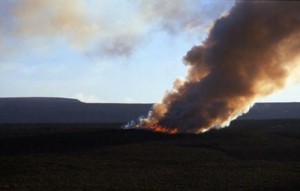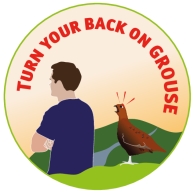
Today the Observer has a piece on the Climate Change Committee’s report to parliament (mentioned on this blog on Wednesday) which raised the issue of intensive grouse moor management ‘The damaging practice of burning peat to increase grouse yields continues, including on internationally protected sites.’.
The article was interesting for a number of reasons.
The Moorland Association’s Amanda Anderson was quoted as saying ‘It probably is fair to say there has been more burning in recent years compared to the preceding decade‘ which is an interesting statement, admission or concession, depending on how you look at things. If moorland burning has intensified, and if it is damaging peatlands and causing higher greenhouse gas emissions, reducing aquatic invertebrates, increasing the acidity of watercourses and perhaps leading to increased flood risk too, then policy makers should be gunning for grouse shooting. After all, grouse shooting is a pastime for the rich, hardly an essential activity in the modern day.
As the RSPB’s Dr Pat Thompson says (quoted in the Observer) ‘The research that has been done to date suggests to us that, when you burn that vegetation off, whether it’s dwarf shrubs like heather or mossy vegetation, you are left with a bare peat surface that is really vulnerable to drying out. The peat blows away or washes away as sediment. Over a period of time, big areas of our peatland have fallen into a really poor state. They are carbon rich, they are often at the heart of some of our key drinking water catchment areas, and these are nationally and internationally important wildlife sites.’. Pat also said ‘It is utterly perverse to me that we are degrading our uplands in a way that benefits the minority rather than society as a whole.’.
So that was quite interesting too, although I was disappointed not to see Andrew Gilruth quoted, as he almost always seems to be in articles which mention YFTBs, as the Observer did. Maybe Andrew would have said ‘The tragedy of over-burning is that it does damage the habitat and the wider environment but you get to shoot more Red Grouse and therefore the gamekeepers who do over-burn are, in some ways, right to do so‘ but I am, of course, just guessing on the basis of previous statements.
 I also saw a new name in the article – at least I thought it a new name – that of Jeremy Herrmann, who is a millionaire hedge-fund manager. I’m really pretty unsighted as to what a hedge-fund is, but Mr Herrmann manages them apparently. He also is very good at catching fish, and owns a couple of grouse moors at Muggleswick (Co Durham) and East Allenheads (Northumberland). But his wasn’t really a new name, as Mr Herrmann appeared in the Ethical Consumer report last year which called on people to turn their backs on grouse and it is said that when Boris Johnson was allegedly up on the moors last autumn (see here) he was visiting Mr Herrmann’s place (or one of them). This wouldn’t be surprising as Mrs Herrmann donated to Boris’s campaign to be Mayor of London and also to David Cameron’s campaign to be top Tory (I don’t know what a hedge fund manager does but Mrs Herrmann seems quite good at hedging her bets).
I also saw a new name in the article – at least I thought it a new name – that of Jeremy Herrmann, who is a millionaire hedge-fund manager. I’m really pretty unsighted as to what a hedge-fund is, but Mr Herrmann manages them apparently. He also is very good at catching fish, and owns a couple of grouse moors at Muggleswick (Co Durham) and East Allenheads (Northumberland). But his wasn’t really a new name, as Mr Herrmann appeared in the Ethical Consumer report last year which called on people to turn their backs on grouse and it is said that when Boris Johnson was allegedly up on the moors last autumn (see here) he was visiting Mr Herrmann’s place (or one of them). This wouldn’t be surprising as Mrs Herrmann donated to Boris’s campaign to be Mayor of London and also to David Cameron’s campaign to be top Tory (I don’t know what a hedge fund manager does but Mrs Herrmann seems quite good at hedging her bets).
[registration_form]
I wonder if satellite (MODIS; too course?) data would confirm or refute Amanda’s observation regarding increased moorland burning? Is this an increased area burnt or frequency of burning or both? You could probably do this analysis at home using downloaded satellite data and QGIS.
SteveJ – good idea. I bet someone has thought of this too…
The Natural Capital Committee says: ‘Peatland restoration on around 140,000 hectares in upland areas…would deliver net benefits of £570m over 40 years in carbon values alone. Further work is needed to determine water quality, recreation and wildlife values. Including these will significantly increase net benefits of such investments.’
Whilst on the figures, I was intrigued by the £60m of public money being paid to moorland owners. This is roughly equal to the gross turnover of the Fc public forests in England – but we will soon, no doubt, be told by the Government that the net cost of c £20m per annum is too much. Which do you think delivers better value to the taxpayer ?
Private Eye has a neat piece on who owns the Highlands; published last week, still on sale.
Makes you weep but Ms Sturgeon is on the case! Pity she doesn’t change the Environment Minister..
I’ve made numerous comments throughout the comments thread below the article, to keep the grouse shooting apologists at bay. Great work with your blog, and thanks for highlighting this issue.
66 dislikes. Really? Looks like an organised opposition. Nice to know they’re worried.
jbc – yes, that’s always encouraging!
Yes, I always judge the success of my commenting, by the degree of the angry response I get. What I’ve found to be the most important technique in combating all advocates of vested interests, but especially shooting interests is this. I think it is important to firmly contradict them with evidence, and not to get distracted by their diversionary tactics, and arguments.
Essentially, like most advocates for the unjustifiable, the advocates for the shooting industry use bluster. They have a shotgun approach to argument, and spray specious arguments everywhere i.e. superficially plausible, but deeply fallacious arguments. This is quite deliberate. They are trying to fool an informed public with a limited attention span, and are not trying to contradict the arguments of the informed, although they give the appearance of doing this. They are only trying to give the superficial appearance of contradicting the arguments of the informed, to give the public the false impression they have a case. In other words, just to superficially give the impression, that the arguments of the informed are flawed. It’s all smoke and mirrors bluster.
This is why it is important tactically, in debate with them, to firmly focus on contradicting them, and not to get involved in advocating different positions with them. They want to play at being equal partners in the argument, and this is why they want to play the game of advocating different positions. In debate, never do what your opponent wants.
As their attempt is to fool the public with false but superficially plausible argument, credibility is everything to these advocates, even though in reality they have none. This is why they get so angry with me directly contradicting them with evidence, and references. Their arguments are fake authoritative arguments, hence the bluster. Yet the less informed public know when someone is contradicted with facts, that they are not as authoritative as they pretending to be. It shakes their confidence when you directly contradict them on the facts, and it bursts their bubble of fake superiority.
My style may seem combative, but I know what I am doing. You see I understand what their tactics are, and I reflect it right back at them. It definitely deters them from persisting with the false arguments they use.